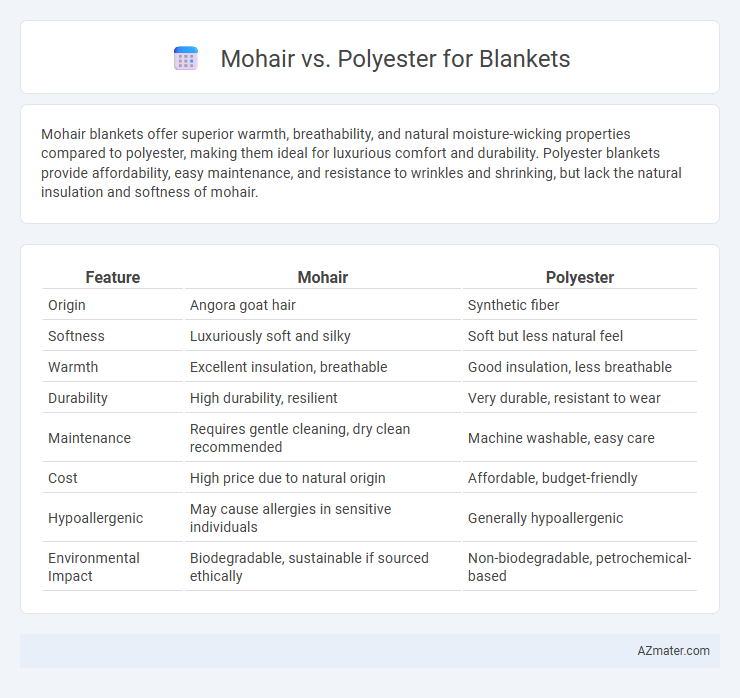Mohair blankets offer superior warmth, breathability, and natural moisture-wicking properties compared to polyester, making them ideal for luxurious comfort and durability. Polyester blankets provide affordability, easy maintenance, and resistance to wrinkles and shrinking, but lack the natural insulation and softness of mohair.
Table of Comparison
| Feature | Mohair | Polyester |
|---|---|---|
| Origin | Angora goat hair | Synthetic fiber |
| Softness | Luxuriously soft and silky | Soft but less natural feel |
| Warmth | Excellent insulation, breathable | Good insulation, less breathable |
| Durability | High durability, resilient | Very durable, resistant to wear |
| Maintenance | Requires gentle cleaning, dry clean recommended | Machine washable, easy care |
| Cost | High price due to natural origin | Affordable, budget-friendly |
| Hypoallergenic | May cause allergies in sensitive individuals | Generally hypoallergenic |
| Environmental Impact | Biodegradable, sustainable if sourced ethically | Non-biodegradable, petrochemical-based |
Introduction to Mohair and Polyester Blankets
Mohair blankets, derived from the fleece of the Angora goat, are prized for their exceptional softness, durability, and natural insulating properties, making them a premium choice for warmth and luxury. Polyester blankets, made from synthetic fibers, offer affordability, ease of care, and resistance to wrinkles and shrinking, appealing to consumers seeking low-maintenance options. Understanding the distinct benefits of mohair and polyester blankets helps buyers select the ideal balance between comfort, durability, and budget.
Fiber Origins: Natural Mohair vs. Synthetic Polyester
Mohair fibers are derived from the natural hair of the Angora goat, known for their silky texture, breathability, and insulating properties, making mohair blankets highly durable and moisture-wicking. Polyester fibers, on the other hand, are synthetic polymers produced through a chemical process, offering affordability, wrinkle resistance, and easy care but lacking the natural temperature regulation and softness of mohair. Choosing between mohair and polyester blankets often depends on the preference for natural fiber benefits versus synthetic convenience and cost-efficiency.
Texture and Softness Comparison
Mohair blankets offer a luxurious, silky texture resulting from the long, smooth fibers of the Angora goat, providing exceptional softness and natural warmth. Polyester blankets have a synthetic feel that can mimic softness but often lack the breathable, lightweight comfort intrinsic to mohair. While polyester is generally more durable and easier to maintain, mohair's superior texture delivers a plush, cozy experience unmatched by synthetic fibers.
Warmth and Insulation Properties
Mohair blankets provide superior warmth and insulation due to their natural fibers, which trap air effectively and regulate body temperature. Polyester blankets offer decent insulation but tend to retain less heat and can cause discomfort by trapping moisture. The moisture-wicking and breathability properties of mohair make it a premium choice for cold-weather comfort compared to synthetic polyester options.
Durability and Longevity
Mohair blankets, made from the lustrous fiber of the Angora goat, are renowned for their exceptional durability and resistance to wear, often lasting decades with proper care. Polyester blankets, while more affordable and resistant to stains and shrinking, typically exhibit reduced longevity due to fiber pilling and lower resilience under repeated use. Choosing mohair over polyester ensures a more durable and long-lasting blanket ideal for both comfort and enduring quality.
Breathability and Moisture Wicking
Mohair blankets excel in breathability, allowing air circulation that prevents overheating and promotes comfort during sleep. The natural fibers of mohair have excellent moisture-wicking properties, quickly drawing sweat away from the skin to keep the sleeper dry and cozy. In contrast, polyester blankets tend to trap heat and moisture due to their synthetic composition, leading to reduced breathability and potential discomfort from sweat accumulation.
Care and Maintenance Requirements
Mohair blankets require delicate care, including dry cleaning or gentle hand washing with mild detergents, as their natural fibers are prone to shrinkage and damage from machine washing. Polyester blankets are low-maintenance, machine washable, and resistant to wrinkles, making them ideal for easy and frequent cleaning without special care. Proper storage in a cool, dry place helps maintain mohair's softness, while polyester's durability allows for less stringent storage conditions.
Allergen Considerations
Mohair fibers, derived from Angora goats, are naturally hypoallergenic and resist dust mites, making mohair blankets an excellent choice for individuals with sensitive skin or allergies. Polyester, a synthetic material, can trap allergens such as dust and pet dander more easily, potentially exacerbating allergic reactions. Choosing mohair blankets minimizes exposure to common airborne allergens and provides superior breathability compared to polyester alternatives.
Environmental Impact and Sustainability
Mohair blankets, derived from the hair of Angora goats, offer a renewable and biodegradable option with lower carbon emissions compared to polyester, which is a synthetic fiber made from petroleum. Polyester production consumes significant fossil fuels and contributes to microplastic pollution in waterways, posing long-term environmental hazards. Choosing mohair supports sustainable livestock farming and reduces reliance on non-renewable resources, making it a more eco-friendly choice for blankets.
Cost Analysis: Mohair vs. Polyester Blankets
Mohair blankets typically carry a higher price tag due to the luxury nature of the fiber sourced from Angora goats, with costs ranging from $150 to over $500 depending on quality and craftsmanship. Polyester blankets are more budget-friendly, averaging between $20 and $60, making them a popular choice for cost-conscious consumers seeking affordable warmth. Despite the initial investment, mohair offers superior durability and natural insulation, potentially reducing long-term replacement expenses compared to polyester alternatives.

Infographic: Mohair vs Polyester for Blanket
 azmater.com
azmater.com